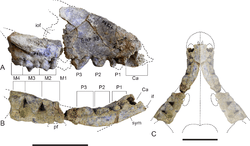Thylacinus potens
| Thylacinus potens Temporal range: Miocene 10–8 Ma | |
|---|---|
 | |
| Upper jaw | |
| Scientific classification | |
| Kingdom: | Animalia |
| Phylum: | Chordata |
| Class: | Mammalia |
| Infraclass: | Marsupialia |
| Order: | Dasyuromorphia |
| Family: | †Thylacinidae |
| Genus: | †Thylacinus |
| Species: | †T. potens |
| Binomial name | |
| Thylacinus potens (Woodburne, 1967) | |

Restoration
Thylacinus potens ("powerful pouch") was the largest species of the family Thylacinidae, originally known from a single poorly preserved fossil discovered by Michael O. Woodburne in 1967 in a Late Miocene locality near Alice Springs, Northern Territory. It preceded the modern thylacine by 4–6 million years,[1] and was 5% bigger,[2] was more robust and had a shorter, broader skull. Its size is estimated to be similar to that of a grey wolf; the head and body together were around 5 feet long, and its teeth were less adapted for shearing compared to those of the modern thylacine.[1]
More specimens were described in 2014.[3]
References
- 1 2 Some Thylacine Relics: Tertiary (page 1)
- ↑ The Lost Kingdoms of Australia by Stephen Wroe
- ↑ Yates, A. M. (2014). "New craniodental remains of Thylacinus potens (Dasyuromorphia: Thylacinidae), a carnivorous marsupial from the late Miocene Alcoota Local Fauna of central Australia". PeerJ. 2: e547. doi:10.7717/peerj.547.
This article is issued from Wikipedia - version of the 8/29/2015. The text is available under the Creative Commons Attribution/Share Alike but additional terms may apply for the media files.